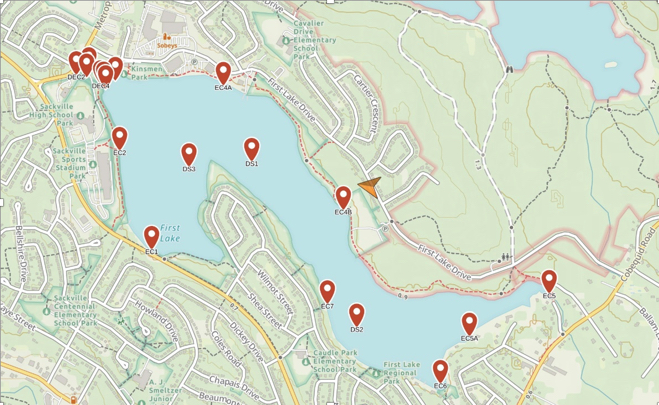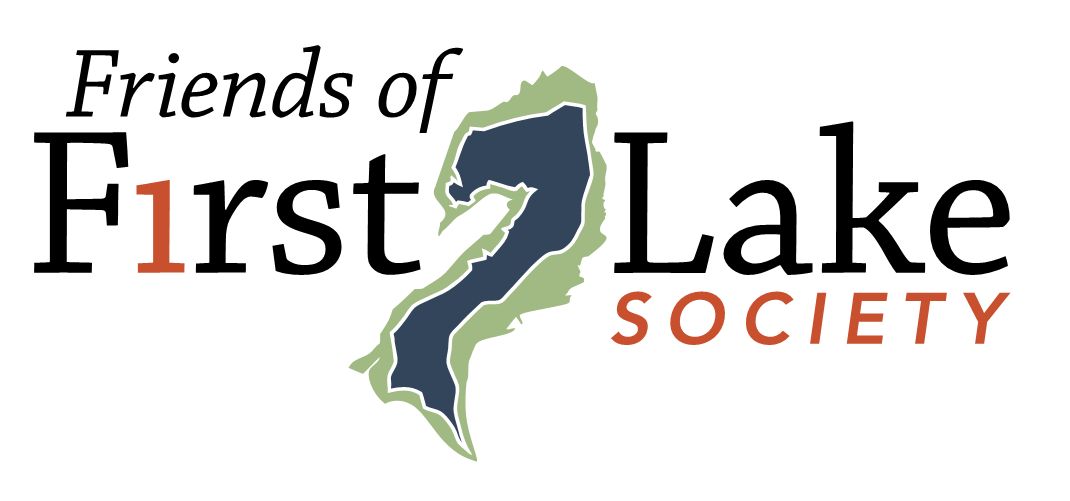Who We Are
The Friends of First Lake (FoFL) Water Stewardship Committee was formed in 2020 and is made up of volunteers who dedicate a significant amount of time and resources to monitoring the water quality of First Lake. The current committee members are Leah Batstone, Monique Guilderson, Janey Hughes, Keith Layman, Travis Mesher, Danny Newton, Paul Russell, and Alan Tattrie. Lab testing was made possible through the support of Councillor Paul Russell. Data interpretation is made possible thanks to Emma Wattie (HRM), Bob Rutherford (Oathill Lake Conservation), and Walter Regan (Sackville Rivers Association), with support from Bruce Batstone. The committee is supported by FoFL, as well as the Sackville Lakes Park and Trails Association, the Sackville Rivers Association, the Atlantic Water Network, and Halifax Regional Municipality (HRM).
What We Do
The Water Stewardship Committee meets regularly throughout the year to discuss concerns related to the lake and plan for the water monitoring season, which lasts from May until October. The committee also strives to promote the importance of protecting First Lake through educational materials, events, and partnerships with local schools and organizations. Lastly, the committee members review historical data, research best practices, and take water monitoring training.
Why We Test
First Lake was routinely monitored by HRM until 2011, at which point they switched to only monitoring E.coli levels. The Water Stewardship Committee was concerned the water quality may have deteriorated during that time due to nearby development, pollution, and other concerns related to an urban lake. The committee wanted to determine if the lake’s overall status had changed in the last ten years and identify any areas of concern so they could be addressed by various levels of government. The committee also wanted to try to learn more about the ongoing E.coli problem near Kinsman Beach.
2021 Summary
The Water Stewardship Committee planned to test the lake monthly from May to October inclusive, but COVID-19 restrictions meant equipment was not accessible to borrow and the lab was not available until late June. The monitoring season was therefore shortened and got underway in July.
When testing began, the committee tested the following areas of the lake:
1. The deepest point of the lake, to get the best representation of overall water quality.
2. Two other deep points in the lake to get a lake profile, for comparison.
3. Eight locations within the lake, plus the ditch adjacent to the beach, to test for E.coli. These locations include the storm drain outlets at Glendale and Chandler, the beach and lakeside of the ditch, Sackawa, behind Eddie Leblanc dog park, Sucker brook outlet, and Judy Ann court beach.

A water profile was collected using YSI sonde throughout the water column at the deepest point in the lake. This provided information on temperature, pH, conductance, dissolved oxygen salinity, and total dissolved solids. The additional samples taken for lab analysis were collected at four separate depths, from the surface to 2 meters from the bottom, to be analyzed for trace metals, nutrients such as phosphorus, nitrogen, calcium, and chlorophyll as a proxy for algae. A Secchi disk was used to assess water clarity. The nine E. Coli samples were taken to help identify areas of concern with the lake to help with the planning of the HRM Pollution study to be carried out in 2022.
2021 Results
The Water Stewardship Committee has compiled the 2021 water monitoring results and made the data available to the public through Atlantic Data Stream. To obtain the complete data set, please go to www.atlanticdatastream.ca and scroll down to Exploring Monitoring Results and click Explore Data or use this direct link https://atlanticdatastream.ca/explore#/sort=create_timestamp&active=false&zoom=5.2&lat=52.690912446906836&lng=-61.521620830861124
Follow the instructions below for either route you chose to get to the Atlantic Data Stream Search page. At that page you will see the Explore Data title at the top. :
Atlantic Data Stream Guide
- Choose “Explore Data” then “Map Search”
- Type in “Friends of First Lake Water Quality Data” to bring up the data set
- Select the Map tab to choose the testing location you would like to view. It is easiest to choose only one at a time. Clear your selection before adding the next location.
- Under the Visualization tab, choose the type of data you want to look at from the drop-down menu listed under Characteristics. Characteristics will only appear in the chart below only if there is data for that characteristic at that testing location. For example, test sites around the perimeter of the lake were only tested for E.coli so that will be the only available characteristic/data.
- The Visualization tab lets you see the data as a graph. The Statistics tab displays information in a table.
- The Explainer tab will provide an explanation for the Characteristics (if available).
Overall, the water quality in First Lake has not changed significantly over the past ten years and the committee has been advised by individuals who reviewed the results that the lake is in good condition for an urban lake.
However, the 2021 water monitoring did reveal that three locations of the lake had high E.coli levels. The Water Stewardship Committee has been liaising with Councillor Paul Russell and HRM as they work on addressing the issue. HRM has contracted a company to analyze E.coli in parts of First Lake and identify the source (human, waterfowl, pet, etc.). HRM expects this report to be completed near the end of 2022.
Highlights of Water Quality Monitoring Results
A sample of what we tested:
- Water temperature: High water temperature can stress aquatic species
- Dissolved oxygen: Amount of oxygen available to aquatic species, minimum amounts are required for survival
- Conductivity: is an indicator of the amount of dissolved solids in the lake, high levels can affect survival of aquatic species
- pH: a measure of the acidity of the water, neutral pH is optimal
- Nutrients: elevated amounts of phosphorus can lead to algae blooms and poor water quality
- Chlorophyll a: a green pigment found in plants, used as a marker for the presence of algae
- Secchi depth: a measure of water clarity
| Temperature Degree C | Dissolved oxygen mg/L | Conductivity uS/cm | pH units | Phosphorus mg/L | Chlorophyll a mg/L | Secchi depth m | |
| 2021 Average | 15.74 | 4.97 | 390.1 | 7.04 | 0.02 | 0..0025 | 4.2 |
| 2021 Min-Max | 8.9-24.1 | 0.0-9.1 | 338-469 | 6.53-7.62 | 0.004-0.16 | 0.0020-0.0034 | 2.8-5.73 |
| HRM 2006-2011 Min-Max | 7.1-24.8 | 8.7-12.3 | 386-580 | 6.76-7.95 | 1m-0.006-0.046 Deep-0.007-0.011 | 0.0014-0.019 | 1.5-8.1 |
What Comes Next
The Water Stewardship Committee will continue monitoring the water quality of First Lake in 2022 and beyond. The committee will also continue working on community education efforts and government advocacy to help improve the water quality. In addition to the E.coli studied described above, HRM also plans to test First Lake twice a year on a go-forward basis. These combined efforts will help to understand the water quality in the lake and provide a basis for improving the health of the lake. The goal of the committee and FoFL is to improve the health of the lake so it can continue to be enjoyed by the community.
